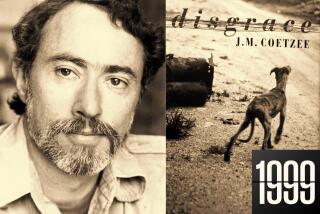A Spirit on the Move : ANATOMY OF RESTLESSNESS: Selected Writings 1969-1989.<i> By Bruce Chatwin (Viking Penguin: $23.95, 206 pp.)</i>
- Share via
Early death is frequently seen as a sort of martyrdom. Bruce Chatwin’s tragic death in 1989 at the age of 49 is often depicted that way, and the acolytes who have gathered round his flame have proven to be pretty passionate in advancing the solemn personal myth that Chatwin sometimes helped along and sometimes mocked. Smirk even for a moment at the stained-glass window these people have put together out of ill-assorted chunks of colored glass and you risk being attacked, as I was for a little portrait I wrote of Chatwin a few years ago. In it, I suggested that he was something of a mythomaniac and had a screaming laugh and bizarre conceits that provoked him to such behavior as monologuing to the mountaineers Lord Hunt and Chris Bonington about great climbs he had made.
His audacity was part of his crazy charm. How else could he have gotten on with the likes of Werner Herzog and Robert Mapplethorpe and (so he reported) Georges Braque? I enjoyed him for his contradictions, but I found that the more he admired someone, the more he talked. He was wildly insecure. So I liked being with him and I was exhausted and grateful when he hurried away--to see a woman weightlifter in Capri or a fruit-bat in Madagascar or (as he tells us in this new collection of pieces) to hold “a conversation with Andrew Breton about the fruit machines in Reno.”
Chatwin insists here and elsewhere that he spent his life flying by the seat of his pants (a poor student, a muddler, a bit of a con man as a Sotheby’s art valuer). You have the impression he wants you to contradict him, and yet I have no trouble seeing him airborne, whizzing skyward, propelled by only his pants. I think nervousness, not arrogance, made him a poseur. “I aired my scanty knowledge of the French Impressionists. . . . I particularly enjoyed telling people that their paintings were fake,” he said.
It was not strange that such a restless person was a traveler. Some of us are so much happier alone. He was self-conscious in the company of others; he wanted to impress you with something you didn’t know (he giddily corrected my pronunciation of Gouda and in this present book we are told, “The word ‘fetish’ derives from a Portuguese expression feticceio”--not a lot of people know that, you see). He talked--nervously, interestingly--boasted, joked, gossiped; his mind was always teeming. And then he would need the respite of solitude, or else new listeners.
Needy, and yet also self-sufficient, he was mad about contradictions. The beauties of “In Patagonia” and “Utz” and “The Songlines” are their oddities--the odd lore, the unexpected incident, the queer etymologies. Of course, Bruce tended to recycle his discoveries. In this collection, surely the bottom of the Chatwin barrel, for the umpteenth time Bruce tells us how he figured out the source for the name Patagonia. It was one of Bruce’s etymological coups.
Quite often Bruce got the wrong end of the stick, but he still managed to build a whole edifice upon it. Nomads interested him. He worshiped the nomadic impulse. One of his longest and most complex historical essays on the traveling spirit is built on the fact that “the word Arab means ‘dweller in tents.’ ” But anyone with an Arabic-English dictionary could have told him that, etymologically, Arab means people who express themselves--derivations from the root “arab” mean Arabic, a clear speaker, clarification, an expression--nothing to do with tents. He goes on “as opposed to hazar”--a man who lives in a house--”with the original implication that the latter was less than human.” This again is misleading and untrue.
He had an unstoppable energy for curious inaccuracy. I agree that such waywardness at first blush makes better reading. But, in the long run, the truth is usually very weird indeed, which makes his judgments merely lame. He says that Robert Louis Stevenson is “a second-rater” and “Treasure Island” is “second-rate.” In fact, his clever description of Stevenson is like a self-portrait. In one essay he goes on endlessly about the Hsiung-nu, a nomadic Central Asian people, but nowhere does he add that they were the avatars of the Huns. Had he done so, he perhaps would not have written, as he does here, “Nomads rarely, if ever, destroyed a civilization.”
This collection is not a book for people coming to Chatwin for the first time. Those readers ought to start with “In Patagonia” and work onward from there, taking the books chronologically. They are wonderful books. And it hardly matters how Chatwin lived his life, except that it was a great deal odder and more interesting than the keepers of his flame seem willing to admit. It seemed that he was either the life and soul of a London party or else he was living in a tent in Wagga-Wagga. Of course, there was something in between, which is why I am greatly looking forward to his biography, which is apparently in the works.
More to Read
Sign up for our Book Club newsletter
Get the latest news, events and more from the Los Angeles Times Book Club, and help us get L.A. reading and talking.
You may occasionally receive promotional content from the Los Angeles Times.








